Garbage In, Garbage Out – IELTS Reading Answers
6 min read
Updated On
-
Copy link
Table of Contents

Limited-Time Offer : Access a FREE 10-Day IELTS Study Plan!
The Reading Module of the IELTS can be the top-scoring category, with diligent practice. To achieve the best results in this section, you must understand how to approach and answer the different Question types in the Reading Module. By solving and reviewing Sample Reading Questions from past IELTS papers, you can ensure that your Reading skills are up to the mark.
The Academic passage ‘Garbage In, Garbage Out’ is a reading passage that appeared in an IELTS Test. Try to find the answers to get an idea of the difficulty level of the passages in the actual reading test. If you want more passages to solve, try taking one of our IELTS reading practice tests.
The question types found in this passage are:
Summary Completion
The summary completion is one of the easiest and most common types of questions in the IELTS reading test. There’ll be a summary of information from the passage with blank spaces in between. The test-taker has to read the questions in the summary, scan the information in the paragraph, locate the keyword, understand the paraphrasing, and then answer the blank spaces with appropriate words. The answer shouldn’t exceed the number of words mentioned in the instruction.
Matching Information
The matching information question types in the IELTS reading test assesses the test-taker’s ability to understand various details and specific information from the passage. It requires the test-taker to match statements to paragraphs in the reading passage. These statements could be either reasons, descriptions, summaries, or definitions, facts or explanations. The test-taker is required to search for the specific information in the paragraph and match it to one of the statements.
Garbage In, Garbage Out
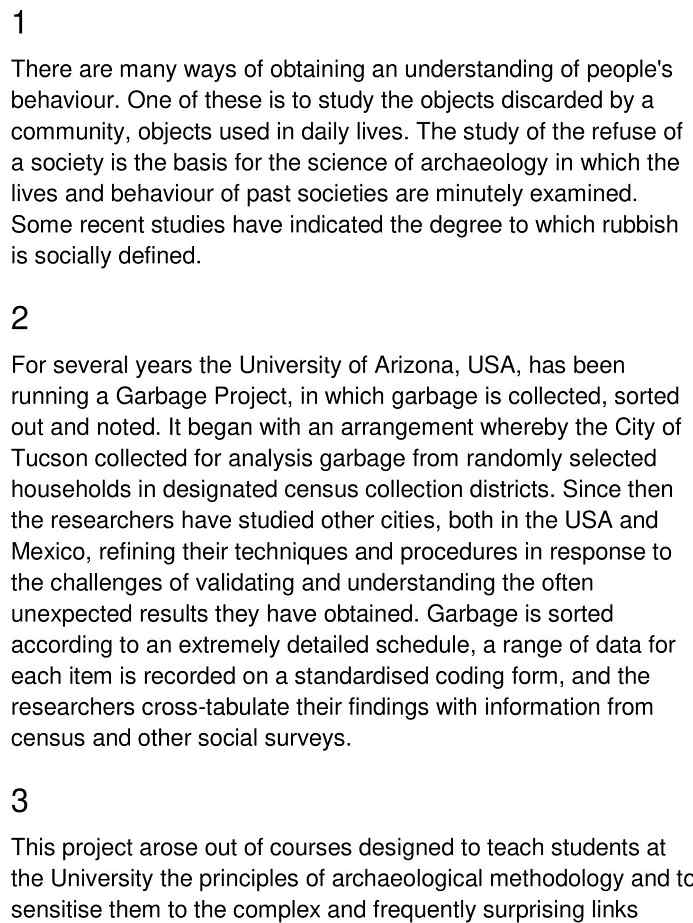
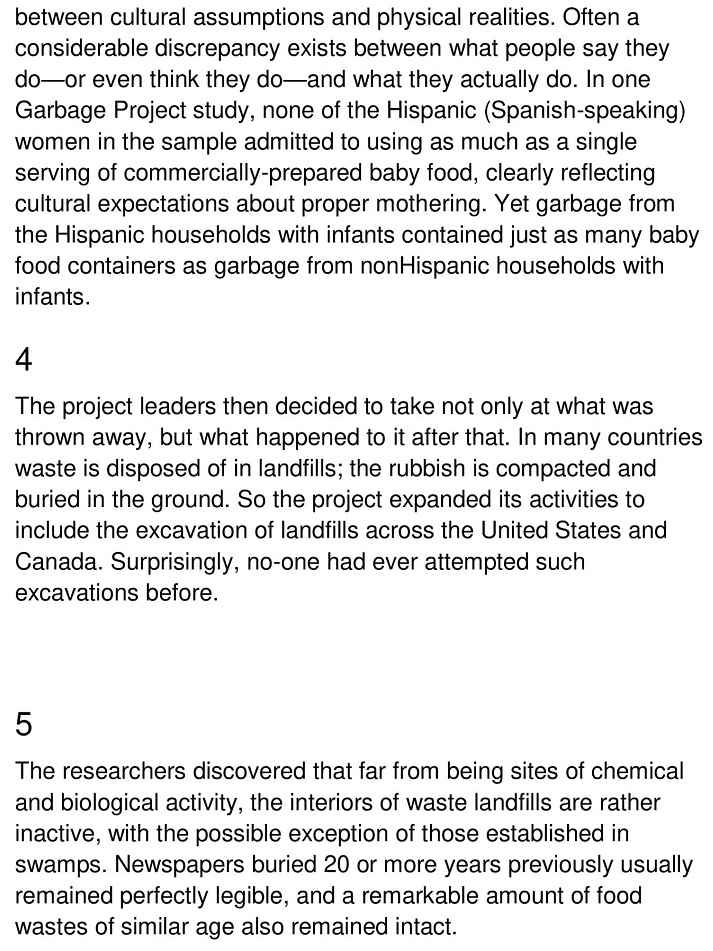
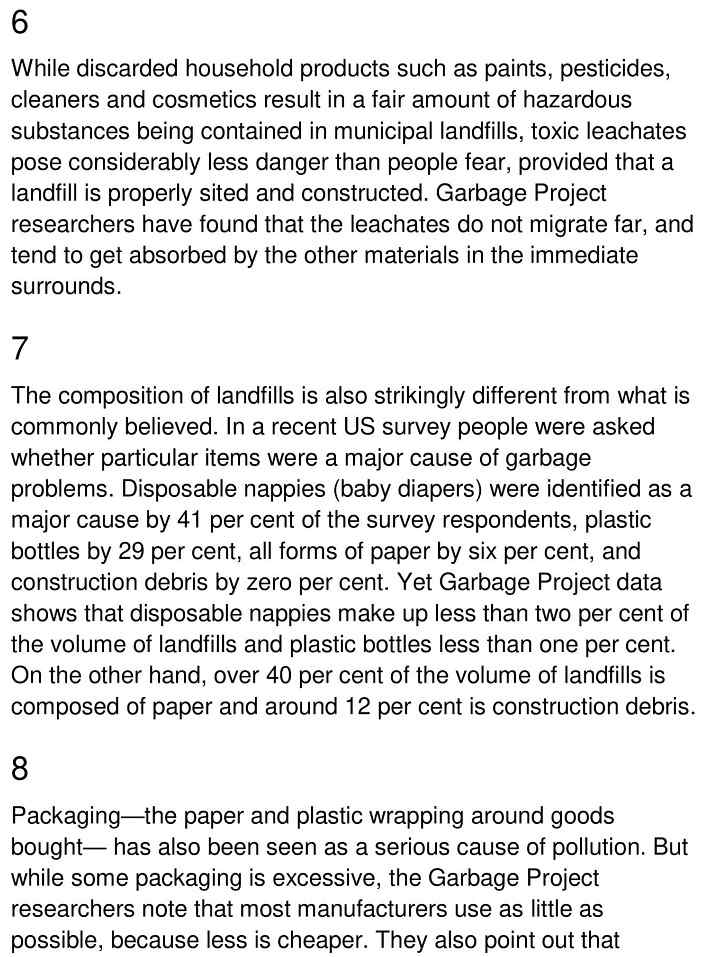

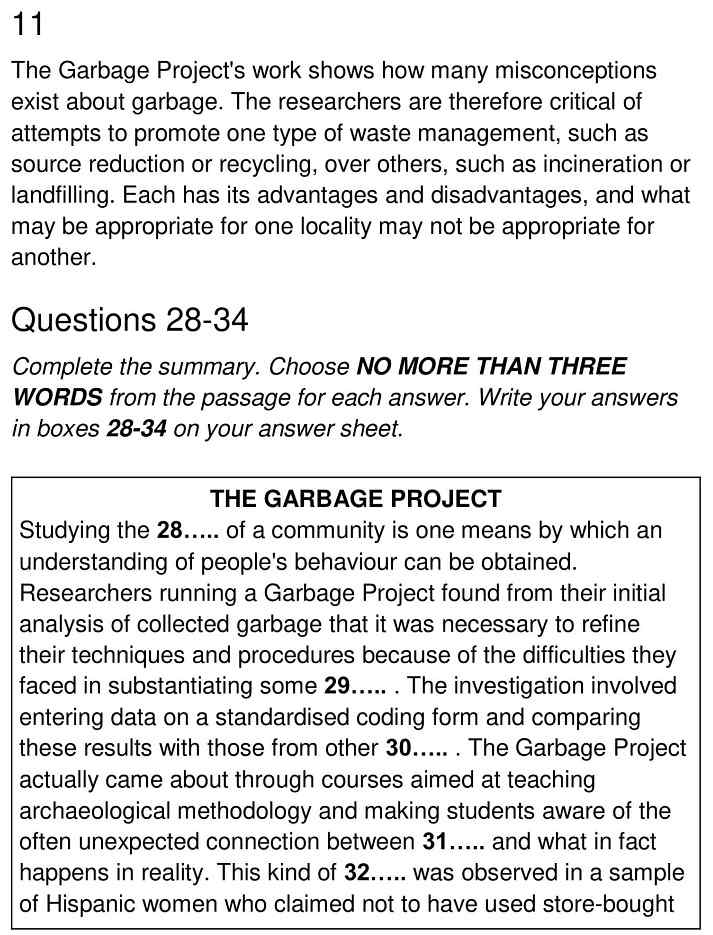

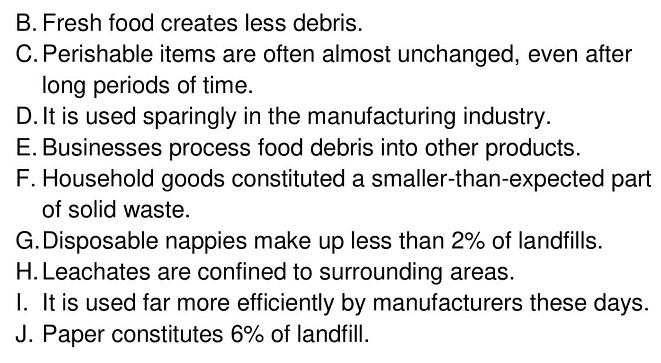
Answers
The answers to questions 28-40 are given below along with their explanation.
28 Answer: refuse
Question type: Summary Completion
Answer location: Paragraph 1, line 3
Answer explanation: We find reference in the 3rd line of the first paragraph, where it is mentioned that the study of the refuse of a society is the basis for the science of archaeology in which the lives and behavior of past societies are minutely examined. These lines clearly indicate that the study of community refuse is one of the means, which will help understand people’s behaviour. Thus, the answer is refuse.
29 Answer: unexpected results
Question type: Summary Completion
Answer location: Paragraph 2, line 5
Answer explanation: We understand from the fifth line in 2nd paragraph that the researchers have studied other cities and both in the USA and Mexico, it was necessary to refine their techniques and procedures in response to the challenges of validating and understanding the unexpected results they’ve obtained. These lines illustrate that it became essential to upgrade the techniques and procedures due to the challenges the countries faced in obtaining the results. So, the answer is unexpected results.
30 Answer: social surveys
Question type: Summary Completion
Answer location: Paragraph 2, line 9
Answer explanation: The ninth line of 2nd paragraph states that garbage is arranged as per the detailed schedule, where a range of data for each product is recorded on a standardized coding form and the researchers would cross tabulate their finding with information from census and other social surveys. We understand that researchers would compare the unexpected results with those from other social surveys. So, the answer is social surveys.
Unlock Answers
31 Answer: cultural assumptions
Question type: Summary Completion
Answer location: Paragraph 3
Answer explanation: We understand from Paragraph 3 that the garbage project arose out of courses aimed at teaching the principles of archaeological methodology and to create awareness between the cultural assumptions and physical realities amongst the students. So, the answer is cultural assumptions.
32 Answer: discrepancy
Question type: Summary Completion
Answer location: Paragraph 3, line 5
Answer explanation: We understand from the 5th line of paragraph 3, that a considerable discrepancy exists between what people say they do and even think they do and what they actually do. So, the answer is discrepancy.
33 Answer: proper mothering
Question type: Summary Completion
Answer location: Paragraph 3, line 6
Answer explanation: We find reference in the 6th line of paragraph 3, where it is mentioned that none of Hispanic women in the sample admitted to using as much as a single serving of commercially prepared baby food, clearly reflecting cultural expectations about proper mothering. These lines clearly illustrate that Hispanic women who didn’t use store-bought baby food expressed their cultural expectations about proper mothering. Hence, the answer is proper mothering.
34 Answer: baby food containers
Question type: Summary Completion
Answer location: Paragraph 3, line 10
Answer explanation: The 10th line in paragraph 3, illustrates that garbage from Hispanic households with babies contained so many baby food containers that they were equal to the non-hispanic households with babies. Thus, the answer is baby food containers.
35 Answer: G
Question type: Matching Information
Answer location: Paragraph 7, line 4
Answer explanation: We understand from the 4th line of paragraph 7, that disposable nappies (baby diapers) were identified as a major cause by 41% of the survey respondents, plastic bottles by 29%, all forms of paper by 6% and construction debris by 0 percent. Thus, the counter argument, G. Disposable nappies makeup less than 2% of the landfills, matches with the misconception. So, the answer is G.
36 Answer: E
Question type: Matching Information
Answer location: Paragraph 9, line 4
Answer explanation: We find references in the 4th line of paragraph 9, which states that even after correcting differences in family size, US households generated far less garbage than the Mexican ones as the US households were highly dependent on processed and packaged foods than Mexican households, as a result, the US households produced much less food debris. The US processor has removed the food that can be used in the manufacture of other products. The misconception western households generate far more than others matches with the counter agreement that businesses process food debris into other products. Here, US processors refer to Businesses which use food debri to manufacture other products. Thus, the answer is E.
37 Answer: C
Question type: Matching Information
Answer location: Paragraph 5, last line
Answer explanation: We find reference in the last line of paragraph 5,where it is indicated that newspapers buried 20 or more years previously remained perfectly legible and a remarkable amount of food wastes of similar age also remained intact. The misconception that germs and bacteria are active and widespread in landfills match with the counter agreement, C – Perishable items are often almost unchanged even after long periods of time. Thus, the answer is C.
38 Answer: F
Question type: Matching Information
Answer location: Paragraph 10
Answer explanation: The introductory line of paragraph 10, illustrates that one criticism made of western societies is that the people are wasteful and throw things away while they’re still usable, which is however, not true. Further, we understand from the 3rd line that the data showed that furniture and consumer appliances were entering the solid waste stream at a rate very much less than would be expected from production and service life ‘gures. The misconception, western societies waste many usable resources matches with the counter agreement that household goods constituted a smaller than expected part of solid waste.
39 Answer: H
Question type: Matching Information
Answer location: Paragraph 6, line 5
Answer explanation: We understand from the fifth line of paragraph 6, that according to the garbage project researchers, the leachates do not migrate far and tend to get absorbed by the other materials in the immediate surroundings. Thus, the misconception, harmful substances are wide-spread in municipal landfills matches with counter agreement, H – Leachates are confined to surrounding areas.
40 Answer: J
Question type: Matching Information
Answer location: Paragraph 7, line 4
Answer explanation: The fourth line of paragraph 7 illustrates that the disposable nappies were identified as a major cause by 41%, plastic bottles by 29%,and all forms of paper by 6% and construction debris by 0%. Thus, the misconception, paper wrapping is wasteful and causes excess garbage matches with the counter agreement, paper constitutes 6% of the landfills. So, the answer is J.
Practice IELTS Reading based on question types

Start Preparing for IELTS: Get Your 10-Day Study Plan Today!
Recent Articles

Nehasri Ravishenbagam

Haniya Yashfeen

Haniya Yashfeen

Haniya Yashfeen
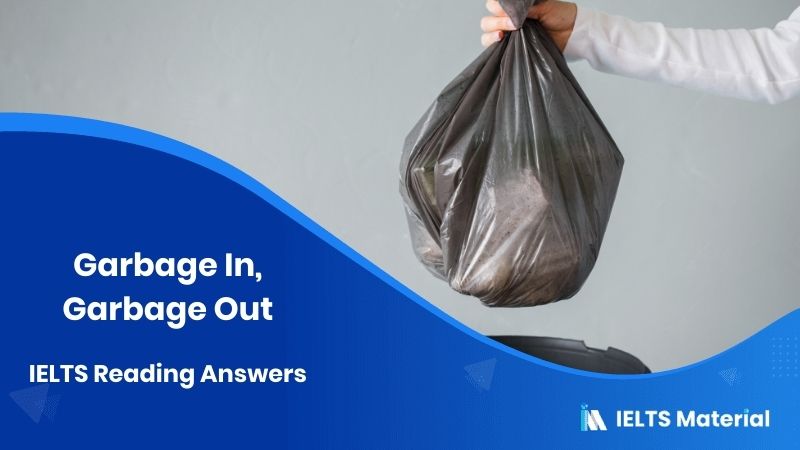



Post your Comments